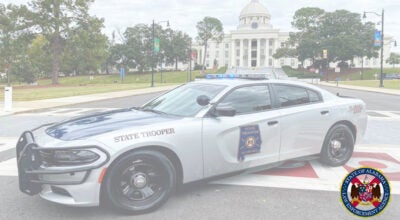COLUMN: D-Day — 80 Years Ago
Published 1:00 pm Friday, June 7, 2024

- The Normandy American Cemetery at Colleville-sur-mer, France, covers 172.5 acres and contains the graves of 9,387 American war dead. [Photo: Pinterest]
|
Getting your Trinity Audio player ready...
|
“There are two kinds of people who are staying on the beach: those who are dead and those who are going to die. Now let’s get the hell of here!”
Colonel George A Taylor – 16th Infantry Regiment, 1st Infantry Division
Omaha Beach – June 6, 1944
“Gentlemen, we will attack tomorrow.” With that short order, Gen. Dwight D. Eisenhower, Supreme Allied Commander in Europe, set in motion the largest amphibious invasion force in history at the time.
Operation Overlord was the code name for the overall invasion that took place on the beaches of Normandy, France, June 6, 1944. The invasion consisted of two main phases: a behind-the-lines airborne assault and the amphibious landings at Normandy. More than 18,000 paratroopers were dropped behind the German defenses shortly after midnight on June 6. The main beach assault consisted of more than 132,000 ground troops that began landing around daylight.
The naval part of the operation, called Operation Neptune, included more than 7,000 naval vessels of every description. In addition to carrying the landing troops, the Navy escorted the troop carriers and provided protection from German submarines and aerial attacks from the Luftwaffe. The Allied air forces flew more than 14,000 sorties to support the landings, although Luftwaffe opposition was minimal.
More than 2,500 American troops were killed on D-Day itself and a further 5,000 wounded.
There were several men from our area who took part in the D-Day invasion. We will try to recap their actions on that day. This list is by no means complete.
Probably the first was Army PFC Thomas Lloyd “Big” Rodgers of the Pleasant Home community who was assigned to the 504th Parachute Infantry Regiment. He was part of an elite squad of 25 men who were called Pathfinders. They were dropped behind enemy lines to mark the landing zones for the paratroopers with lights and radio beacons. Big Rodgers’ body was later found near St. Mere Eglise, surrounded by the bodies of 40 dead German soldiers. Only eight men of the 25 Pathfinders survived. Rodgers was posthumously awarded the Distinguished Service Cross, our nation’s second highest military award for bravery. Rodgers would probably have received the Medal of Honor had there been witnesses to his heroic actions.
Army Air Corps pilot 1st Lt. Thomas Dwight Teel, of Opp, Alabama, was 19 years old and flew six sorties on D-Day. His missions took him across the English Channel six times into France to support of the ground troops. Teel was assigned to the 360th Fighter Squadron, 356th Fighter Group and flew the P-47 Thunderbolt. Teel was credited with shooting down a German ME-109, but was later killed on August 29. He was posthumously awarded the Distinguished Flying Cross as well as the Air Medal with three Oak Leaf Clusters.
Navy Seaman 1/C Max Maloy Foreman, of Andalusia, Alabama, was assigned to PT-515. Information about Max Foreman was provided by his shipmate on PT-515, QM1 Clyde Combs of Houston, Texas. Combs [who is 99 years old] talked with the author about his friend Max and their duties on D-Day. PT-515 and its squadron left England in the pre-dawn hours on D-Day, along with two other PT boat squadrons and more than 100 Navy minesweepers. Their job was to clear the path for the troop carriers and landing craft. Combs recalled, “The gunners on our boat alone blasted some 17 floating mines the first hour we were on station.” The PT boats remained on line for 11 days after the invasion.
Navy SC 3/C Claude Pike was originally from Limestone County but spent most of his life in Andalusia, Alabama. Pike served aboard the LST-543, a large Navy ship that carried landing craft to England from the States. On D-Day, they embarked British troops and equipment and landed them at Juno Beach. The LST had two large bow doors that were opened after the nose of the ship was beached. Jeeps, troops and equipment could unload from the ramps that had been lowered. Pike recalled in a 2018 interview, “We stayed at General Quarters [Battle Stations] around the clock during the invasion. My battle station was topside, manning a 40 mm anti-aircraft gun. I also manned a 20 mm gun.” Strafing German planes were a constant threat as Pike helped defend the ship. His ship made several more trips delivering US troops to Omaha Beach before it was beached by a gale. LST-543 remained stuck on the beach for 19 days before it could be refloated.
Army Tech 5 Roland R. Johnson was originally from Conecuh County but spent most of his life in Andalusia. Johnson was assigned to B Company, 385th Military Police Battalion. At 27 years of age, Johnson had already graduated from college and had served as a teacher and a principal at a small school before joining the Army. Wading ashore on Utah Beach on D-Day was a memory that stayed with Roland Johnson throughout his life. His son, Mayor Earl V. Johnson, recalled his Dad’s conversations about D-Day, “He said that the whole landing was horrible from crossing the English Channel and seeing the high cliffs above the landing beaches to watching his friends get shot as they exited the landing craft. Some men were shot in the landing craft. The water around the beach was red with American blood.” The 385th fought on through France, Belgium and was in Germany when the war ended.
Army Air Corps SSGT Luther E. Brown, Jr. of Andalusia, Alabama, was a radio operator on a B-24 Liberator bomber with the 392nd Heavy Bombing Group on D-Day. Brown attended Andalusia High School before joining the Army in August 1942. The 392nd flew missions over Holland, Belgium, France, Norway, Poland and Germany. Its 100th mission was in support of the D-Day landings. SSGT Brown received the Air Medal with five Oak Leaf Clusters, three battle stars and The Presidential Unit Citation [for the 392nd].
Army PFC Bruce Sheppard of Covington County landed at Normandy on D-Day. He was wounded and taken to England where he remained until July 30. Sheppard was sent overseas in August 1942 and had taken part in campaigns in N. Africa and Sicily. He received the Silver Star, the Bronze Star, the Purple Heart and the Combat Infantry Badge. After recovering from his wounds from D-Day, Sheppard was assigned to a Military Police Special Investigation Squad in Paris.
Army PFC Norman L. Mitchell was from Hacoda, Alabama, but was raised in Florala, Alabama. Mitchell joined the Army in 1942 and took part in the Normandy landings on D-Day. Mitchell was killed in action on July 19 as he took part in the Army’s push through northern France.
Army Flight Officer Cecil G. Parrish was from Wing, Alabama, and was a glider pilot. He flew his CG-4A Glider behind the lines early on the morning of June 6, 1944, delivering troops and equipment. He wrote home, “We landed with little difficulty and all personnel and equipment were saved. Enroute to Command Post, we came across two paratroopers with broken legs and gave them what assistance we could…The French people were very friendly and gave us wine, bread and coffee…We are glad to be back but are itching to go again.” Parrish was awarded two Bronze Stars, seven battle stars and the Air Medal with two Oak Leaf Clusters.
Army Air Corps Tech Sergeant Palmer D. Bryan was from the Searight Community north of Andalusia, and graduated from Rawls High School. He was a radio operator on a B-24 Liberator bomber called “Black Magic” that flew two missions on D-Day in support of the landings. Sheppard flew 31 combat missions and recalled, “Our toughest mission was over Brunswick. We got in a concentration of flak…Our ship was pretty badly shot up. We had to leave the formation and head back to home base. Luck was with us and we got there safely.” Bryan was awarded the Distinguished Flying Cross and the Air Medal with three Oak Leaf Clusters.
Army CPL. Oran Zim Corbin was from Florala, Alabama. He was a paratrooper and landed behind the lines on D-Day. He spent 36 months in the European Theater of Operations.
Army PFC Colice Mock was from Opp, Alabama. He entered the Army Sep. 10, 1941. Mock had spent 18 months with the 8th Army in the European Theater prior to taking part in the D-Day landings. He was killed in action during the Normandy invasion.
Army PVT Grady E. Colvin was from Opp, Alabama. He volunteered for the Army and was a member of the 741st Tank Battalion that landed on Omaha Beach. Colvin’s battalion was trying to land on “duplex tanks.” These were M4 Sherman tanks that were fitted with a rubberized collar and an external propeller drive. About 90% of these tanks sunk before making it to the beach. In July 1944, Colvin’s mother, Lena K. Colvin, received the following letter from Army Capt. Joseph A. Archibald III, “I am the Captain of a U.S. Army tug which has been stationed in the British sector of the Normandy beachhead. On the 26th of June, the Captain of a British Cruiser told me that he had recovered the body of your son, PVT Grady E. Colvin, from the water. He asked my advice and I told him to send the identification tags to the Adjutant General’s Office in Washington….I told him I would bury your son at sea because I wanted him to be buried under an American Flag….So at dusk on the 26th of June, I pointed the bow of the ship toward America and with all the military honor I could muster on a tug, I buried your son, Grady, in the English Channel. I had to wait this long before writing because of war department regulations.”
Army PFC James I. Williamson was from Andalusia, Alabama. Williamson was assigned to the 131st Field Artillery Battalion, 36th Infantry [called the Texas or the Arrowhead] Division. He fought with the 131st in Italy before taking part in the Normandy invasion. He was awarded the Bronze Arrowhead to wear on his European Theater of Operations ribbon.
Army PFC Comer W. Burney was from Florala, Alabama. He was a member of Company B, 147th Engineer Combat Battalion and landed at Omaha Beach around noon on June 6. The combat engineers brought bulldozers and equipment to build roads from the beaches for tanks, jeeps and personnel carriers. By the end of the day, the 147th bulldozers were digging ditches, a blade wide, to temporarily bury body bags of dead soldiers. PFC Burney made it through D-Day and that winter, wrote his mother, Mrs. M.E. Burney, that he was in Holland where there was eight inches of snow on the ground.
Army PVT. William L. Ludlam was from Red Level, Alabama, and was a member of Battery A, 42nd Field Artillery Battalion that supported the 4th Infantry Division landings at Utah Beach. He was killed in action on D-Day.
John Vick
[Sources: ancestry.com; miscellaneous newspaper articles from The Andalusia Star, The Opp News and The Florala News; Wikipedia; history.com; Eisenhower Presidential Library; the Associated Press]




